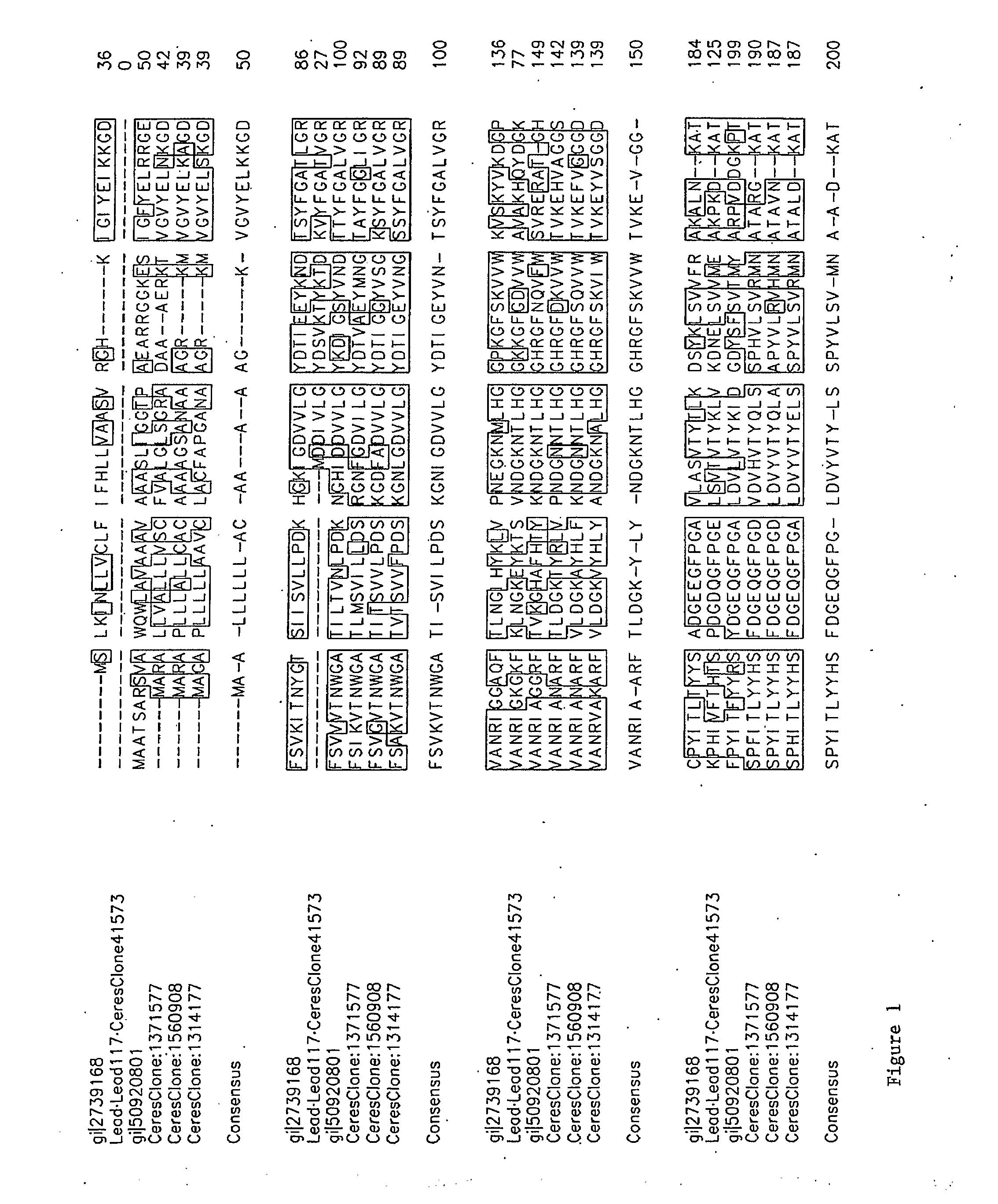Modulating plant oil levels
a technology of plant oil and level, applied in the field of moduleating plant oil levels, can solve the problems of inability to detect the introduction of nucleic acid in daughter cells, and consuming too much saturated fa
- Summary
- Abstract
- Description
- Claims
- Application Information
AI Technical Summary
Benefits of technology
Problems solved by technology
Method used
Image
Examples
example 1
Transgenic Plants
[0312]The following symbols are used in the Examples: T1: first generation transformant; T2: second generation, progeny of self-pollinated T1 plants; T3: third generation, progeny of self-pollinated T2 plants; T4: fourth generation, progeny of self-pollinated T3 plants. Independent transformations are referred to as events.
[0313]The following is a list of nucleic acids that were isolated from Arabidopsis thaliana plants. Ceres Clone 25429 (At3g44590; SEQ ID NO:93) is a cDNA clone that is predicted to encode a 113 amino acid (SEQ ID NO:94) ribosomal polypeptide. Ceres Clone 41573 (At5g15140; SEQ ID NO:80) is a cDNA clone that is predicted to encode a 298 amino acid (SEQ ID NO:81) aldose 1-epimerase polypeptide. Ceres Clone 5750 (At2g27960; SEQ ID NO:110) is a cDNA clone that is predicted to encode an 87 amino acid (SEQ ID NO:111) cyclin-dependent kinase regulatory subunit polypeptide. Ceres Clone 121021 (SEQ ID NO:151) is a DNA clone that is predicted to encode a 199...
example 2
Analysis of Oil Content in Transgenic Arabidopsis Seeds
[0318]An analytical method based on Fourier transform near-infrared (FT-NIR) spectroscopy was developed, validated, and used to perform a high-throughput screen of transgenic seed lines for alterations in seed oil content. To calibrate the FT-NIR spectroscopy method, a sub-population of transgenic seed lines was randomly selected and analyzed for oil content using a direct primary method. Fatty acid methyl ester (FAME) analysis by gas chromatography-mass spectroscopy (GC-MS) was used as the direct primary method to determine the total fatty acid content for each seed line and produce the FT-NIR spectroscopy calibration curves for oil.
[0319]To analyze seed oil content using GC-MS, seed tissue was homogenized in liquid nitrogen using a mortar and pestle to create a powder. The tissue was weighed, and 5.0±0.25 mg were transferred into a 2 mL Eppendorf tube. The exact weight of each sample was recorded. One mL of 2.5% H2SO4 (v / v in ...
example 3
Analysis of Protein Content in Transgenic Arabidopsis Seeds
[0326]An analytical method based on Fourier transform near-infrared (FT-NIR) spectroscopy was developed, validated, and used to perform a high-throughput screen of transgenic seed lines for alterations in seed protein content. To calibrate the FT-NIR spectroscopy method, total nitrogen elemental analysis was used as a primary method to analyze a sub-population of randomly selected transgenic seed lines. The overall percentage of nitrogen in each sample was determined. Percent nitrogen values were multiplied by a conversion factor to obtain percent total protein values. A conversion factor of 5.30 was selected based on data for cotton, sunflower, safflower, and sesame seed (Rhee, K. C., Determination of Total Nitrogen In Handbook of Food Analytical Chemistry—Water, Proteins, Enzymes, Lipids, and Carbohydrates (R. Wrolstad et al., ed.), John Wiley and Sons, Inc., p. 105, (2005)). The same seed lines were then analyzed by FT-NI...
PUM
| Property | Measurement | Unit |
|---|---|---|
| time | aaaaa | aaaaa |
| time | aaaaa | aaaaa |
| time | aaaaa | aaaaa |
Abstract
Description
Claims
Application Information
 Login to View More
Login to View More - R&D
- Intellectual Property
- Life Sciences
- Materials
- Tech Scout
- Unparalleled Data Quality
- Higher Quality Content
- 60% Fewer Hallucinations
Browse by: Latest US Patents, China's latest patents, Technical Efficacy Thesaurus, Application Domain, Technology Topic, Popular Technical Reports.
© 2025 PatSnap. All rights reserved.Legal|Privacy policy|Modern Slavery Act Transparency Statement|Sitemap|About US| Contact US: help@patsnap.com



